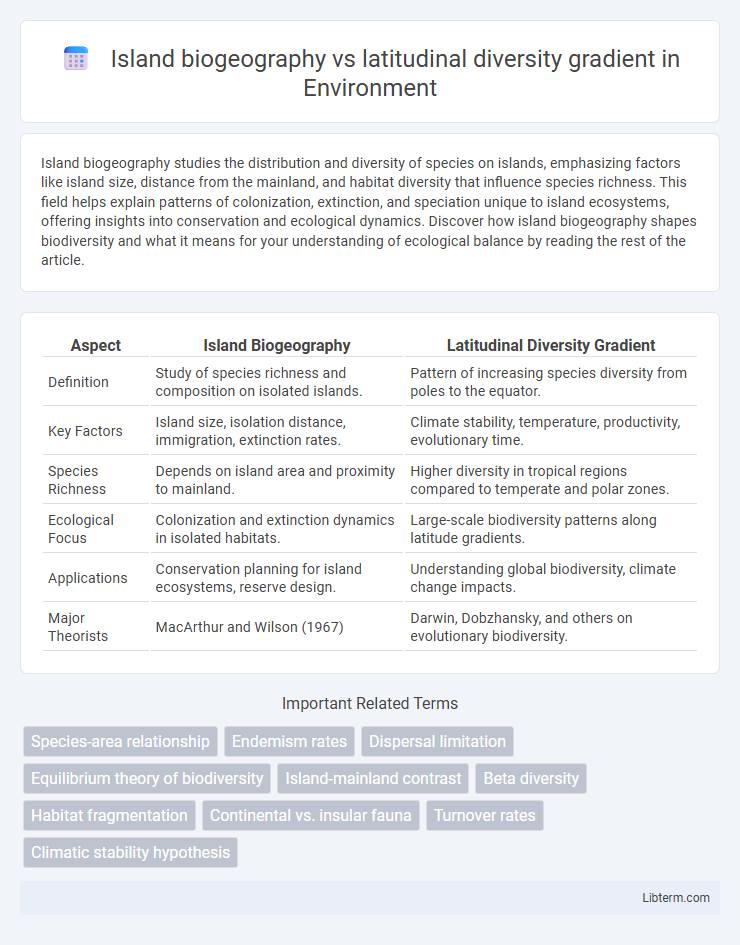Island biogeography studies the distribution and diversity of species on islands, emphasizing factors like island size, distance from the mainland, and habitat diversity that influence species richness. This field helps explain patterns of colonization, extinction, and speciation unique to island ecosystems, offering insights into conservation and ecological dynamics. Discover how island biogeography shapes biodiversity and what it means for your understanding of ecological balance by reading the rest of the article.
Table of Comparison
| Aspect | Island Biogeography | Latitudinal Diversity Gradient |
|---|---|---|
| Definition | Study of species richness and composition on isolated islands. | Pattern of increasing species diversity from poles to the equator. |
| Key Factors | Island size, isolation distance, immigration, extinction rates. | Climate stability, temperature, productivity, evolutionary time. |
| Species Richness | Depends on island area and proximity to mainland. | Higher diversity in tropical regions compared to temperate and polar zones. |
| Ecological Focus | Colonization and extinction dynamics in isolated habitats. | Large-scale biodiversity patterns along latitude gradients. |
| Applications | Conservation planning for island ecosystems, reserve design. | Understanding global biodiversity, climate change impacts. |
| Major Theorists | MacArthur and Wilson (1967) | Darwin, Dobzhansky, and others on evolutionary biodiversity. |
Introduction to Island Biogeography and Latitudinal Diversity Gradient
Island biogeography examines species richness and distribution based on island size, isolation, and colonization-extinction dynamics, highlighting the balance between immigration and extinction rates. The latitudinal diversity gradient describes the increase in species diversity from the poles toward the equator, driven by factors such as climate stability, energy availability, and evolutionary rates. Both concepts explain biodiversity patterns, but island biogeography emphasizes spatial constraints while the latitudinal diversity gradient focuses on climatic and ecological gradients.
Historical Development of Both Concepts
Island biogeography emerged from MacArthur and Wilson's 1967 equilibrium theory, explaining species richness on islands as a dynamic balance between immigration and extinction rates influenced by island size and distance. The latitudinal diversity gradient concept, recognized since the 19th century, gained scientific rigor through extensive research highlighting the increase in species richness from poles to the equator due to climatic stability, energy availability, and evolutionary history. Both concepts evolved with advancements in ecological modeling and empirical data, shaping modern biodiversity and conservation science.
Key Principles of Island Biogeography
Island biogeography emphasizes the balance between species immigration and extinction rates, influenced by island size and isolation, shaping species richness. Larger islands closer to the mainland support higher biodiversity due to increased habitat diversity and easier colonization. These principles contrast with the latitudinal diversity gradient, which highlights biodiversity decreasing from the equator to the poles driven by climate and energy availability.
Core Ideas of the Latitudinal Diversity Gradient
The Latitudinal Diversity Gradient reveals that species richness increases from the poles toward the equator due to factors such as higher solar energy input and stable climates. This gradient highlights the importance of environmental energy, habitat heterogeneity, and evolutionary history in shaping global biodiversity patterns. Contrasting with Island Biogeography, which emphasizes isolation and area effects on species richness, the Latitudinal Diversity Gradient focuses on broad-scale climatic and ecological drivers influencing species distribution.
Mechanisms Driving Island Biogeography
Island biogeography is primarily driven by mechanisms such as immigration, extinction, and speciation rates, influenced by island size and isolation. These factors determine species richness through dynamic equilibrium models, emphasizing species turnover and habitat heterogeneity. In contrast, the latitudinal diversity gradient reflects broad-scale patterns shaped by climate stability, productivity, and evolutionary time spans, which affect species distribution across latitudes rather than isolated ecosystems.
Factors Shaping the Latitudinal Diversity Gradient
The latitudinal diversity gradient, characterized by higher species richness near the equator and declining towards the poles, is influenced by factors such as climate stability, habitat heterogeneity, and productivity. Island biogeography emphasizes island size and isolation as key determinants of species richness, but latitudinal gradients highlight evolutionary rates and historical climate fluctuations as major drivers. These factors collectively shape global biodiversity patterns by affecting speciation, extinction, and dispersal processes along latitudinal lines.
Comparative Patterns in Species Richness
Island biogeography theory explains species richness through isolation and island size, with smaller and more isolated islands typically supporting fewer species due to limited immigration and higher extinction rates. The latitudinal diversity gradient shows a consistent increase in species richness from poles to the equator, driven by factors such as climatic stability, productivity, and evolutionary rates. Comparative patterns reveal that while island biogeography emphasizes spatial constraints and dispersal, the latitudinal diversity gradient highlights broad-scale environmental and evolutionary processes shaping global biodiversity.
Case Studies and Empirical Evidence
Research on island biogeography highlights the role of isolation and area in shaping species richness, with classic case studies such as the species turnover on the Galapagos Islands demonstrating equilibrium between colonization and extinction rates. Latitudinal diversity gradient studies provide empirical evidence that species richness systematically increases from poles to the equator, as shown by diversity patterns in freshwater fish across the Americas and in bird populations globally. Combining these frameworks, empirical data from Caribbean island archipelagos illustrate how latitude constrains regional species pools while island size and isolation govern local community assembly.
Implications for Conservation and Biodiversity
Island biogeography highlights the importance of habitat size and isolation in maintaining species richness, crucial for designing effective conservation reserves and preventing local extinctions. The latitudinal diversity gradient emphasizes higher biodiversity in tropical regions, guiding prioritization of conservation efforts toward equatorial ecosystems with exceptional species endemism. Combining insights from both concepts enhances strategies for preserving global biodiversity hotspots and mitigating the impacts of habitat fragmentation and climate change.
Synthesis and Future Research Directions
Island biogeography theory explains species richness through island size and isolation, while latitudinal diversity gradient addresses species richness variation with latitude. Synthesizing these frameworks involves integrating spatial scale, evolutionary processes, and environmental gradients to better understand biodiversity patterns globally. Future research should prioritize mechanistic models combining species dispersal, extinction rates, and climate variables to predict shifts under global change scenarios.
Island biogeography Infographic

 libterm.com
libterm.com